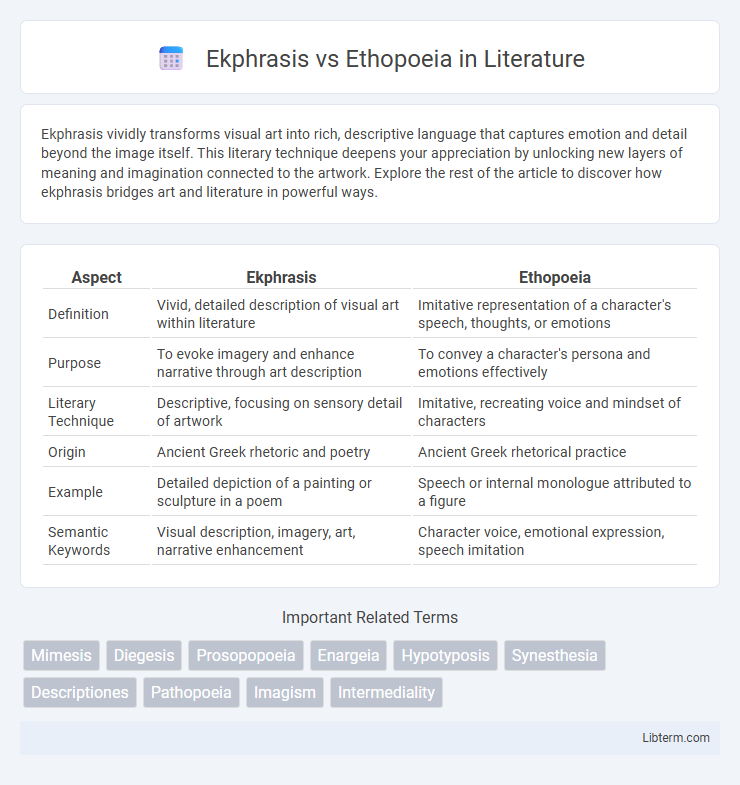Ekphrasis vividly transforms visual art into rich, descriptive language that captures emotion and detail beyond the image itself. This literary technique deepens your appreciation by unlocking new layers of meaning and imagination connected to the artwork. Explore the rest of the article to discover how ekphrasis bridges art and literature in powerful ways.
Table of Comparison
| Aspect | Ekphrasis | Ethopoeia |
|---|---|---|
| Definition | Vivid, detailed description of visual art within literature | Imitative representation of a character's speech, thoughts, or emotions |
| Purpose | To evoke imagery and enhance narrative through art description | To convey a character's persona and emotions effectively |
| Literary Technique | Descriptive, focusing on sensory detail of artwork | Imitative, recreating voice and mindset of characters |
| Origin | Ancient Greek rhetoric and poetry | Ancient Greek rhetorical practice |
| Example | Detailed depiction of a painting or sculpture in a poem | Speech or internal monologue attributed to a figure |
| Semantic Keywords | Visual description, imagery, art, narrative enhancement | Character voice, emotional expression, speech imitation |
Introduction to Ekphrasis and Ethopoeia
Ekphrasis is a vivid, often dramatic, literary description of a visual work of art, aiming to bring the image to life through detailed and imaginative language. Ethopoeia involves the rhetorical practice of impersonating or portraying the character, emotions, and speech of another person, often to capture their psychological and moral essence. Both techniques serve to enhance narrative depth and reader engagement by merging visual or psychological elements with verbal expression.
Historical Origins of Ekphrasis
Ekphrasis originated in ancient Greek literature as a vivid, detailed description of visual art intended to evoke its imagery and emotional impact through words. Historically, figures like Homer and later classical poets employed ekphrasis to bring mythological scenes and artworks to life within their epics and dramas. This literary technique contrasts with ethopoeia, which centers on character portrayal and speech imitation rather than the visual depiction emphasized by ekphrasis.
The Evolution of Ethopoeia
Ethopoeia evolved as a rhetorical technique focusing on the vivid portrayal of a character's emotions, personality, and motives in speech or writing, differing from ekphrasis, which centers on the descriptive depiction of visual art or scenes. Originating in classical rhetoric, ethopoeia expanded through medieval and Renaissance literature, emphasizing emotional depth and internal character expression. Modern applications of ethopoeia highlight psychological realism and character-driven narratives, reflecting the technique's adaptation to contemporary storytelling and analytical discourses.
Key Differences Between Ekphrasis and Ethopoeia
Ekphrasis involves vivid, detailed descriptions of visual art, capturing the essence and emotional impact of the artwork within a literary text. Ethopoeia centers on representing a character's voice, thoughts, or personality, often through direct speech or internal monologue, to convey their emotions and intentions. The key difference lies in ekphrasis focusing on external artistic depiction, while ethopoeia emphasizes internal character portrayal.
Ekphrasis in Classical and Modern Literature
Ekphrasis in classical literature often involves vivid, detailed descriptions of visual art, serving as a bridge between visual and verbal storytelling by capturing the essence of sculptures or paintings, as seen in Homer's portrayal of Achilles' shield. Modern literature expands ekphrasis beyond mere description, using it to explore deeper themes and evoke emotional responses, exemplified in works like W.H. Auden's adaptation of ancient art or John Keats' "Ode on a Grecian Urn." Both classical and modern ekphrastic texts emphasize the power of language to animate static images, transforming them into dynamic narrative devices that engage readers' imaginations.
Ethopoeia’s Role in Rhetoric and Characterization
Ethopoeia plays a crucial role in rhetoric by enabling speakers and writers to adopt the voice, emotions, and perspective of another character or person, thereby enhancing persuasive impact and emotional engagement. It functions as a powerful tool for characterization, allowing the rhetorician to vividly portray personalities, motives, and attitudes, which deepens the audience's understanding and connection to the narrative. Unlike ekphrasis, which centers on descriptive imagery, ethopoeia emphasizes empathetic representation and the enactment of character traits within discourse.
Techniques and Approaches in Ekphrasis
Ekphrasis employs vivid, sensory-rich descriptions to transform visual art into dynamic verbal imagery, often using metaphor and detailed observation to evoke the original work's emotional and aesthetic impact. Techniques include spatial arrangement, color emphasis, and motion depiction to create immersive experiences that bring static images to life through language. Unlike ethopoeia, which centers on character portrayal and internal thoughts, ekphrasis prioritizes external representation, focusing on precise, graphic depiction and narrative enhancement of artwork.
Methods of Crafting Ethopoeia
Ethopoeia involves crafting vivid character personas by reconstructing speech patterns, emotions, and psychological traits to evoke authenticity in literary works. This method employs detailed observation of behavior, tone, and context to render characters' unique voices, often integrating direct and indirect discourse for depth. Unlike ekphrasis, which visually describes art, ethopoeia dynamically generates internal character ethos through empathetic imagination and rhetorical strategies.
Comparative Analysis: Ekphrasis vs Ethopoeia
Ekphrasis and ethopoeia differ in their representational focus; ekphrasis vividly describes visual art or scenes to evoke sensory experience, while ethopoeia reconstructs a character's speech or thoughts to reveal inner psychology. Ekphrasis emphasizes detailed, often visual imagery to engage the audience's imagination, contrasting with ethopoeia's emphasis on rhetorical embodiment and the authentic voice of a persona. This comparative analysis highlights ekphrasis as external, image-driven expression and ethopoeia as internal, character-driven narrative.
Contemporary Applications and Relevance
Ekphrasis in contemporary literature often serves as a vivid narrative tool, enabling writers to create immersive visual experiences through detailed descriptions of artworks or scenes, thereby enhancing emotional engagement and thematic depth. Ethopoeia remains relevant in modern storytelling by facilitating character development and psychological insight through the dramatization of internal thoughts and emotions, often employed in diverse media including film, theater, and digital narratives. Both techniques are essential in digital humanities and multimedia projects for enriching textual interpretation and audience interaction in an increasingly visual and interactive culture.
Ekphrasis Infographic

 libterm.com
libterm.com